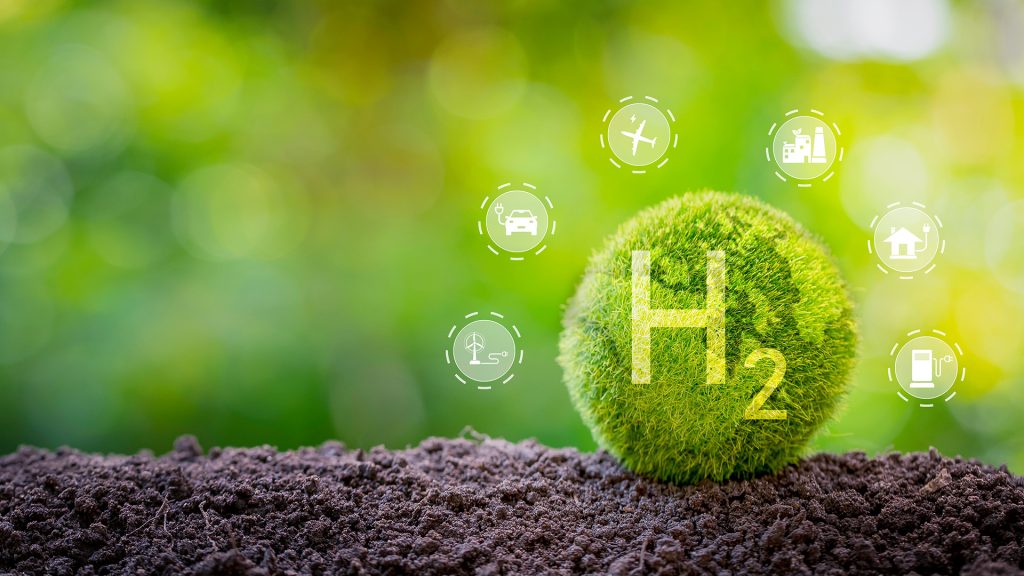India is on the cusp of a significant transformation in its energy sector, with green hydrogen emerging as a pivotal element in the nation’s clean energy transition. As the country strives for energy independence by 2047 and aims to achieve net-zero emissions by 2070, green hydrogen offers a sustainable pathway to decarbonise various industries and position India as a global leader in sustainability.
Current landscape and growth potential
The term “Green Hydrogen” is given based on the emission threshold of 2 kg CO2 eq per kg H2 in the production process. Green hydrogen, produced through the electrolysis of water using renewable energy sources like solar and wind, has garnered substantial attention in India.
The National Green Hydrogen Mission, launched by the Indian government, has projected that India’s green hydrogen production capacity will reach 5 MMTPA by 2030, with the potential to scale up to 10 MMTPA depending on export market growth.

The Government of India has supported with various incentives and policy supports, including PLI of Rs 19,744 crore for green hydrogen production & electrolyser manufacturing. By 2050, nearly 94 per cent of hydrogen demand could be met through GH2, up from 16 per cent in 2030. The cumulative market value of green hydrogen in India is expected to grow from $8 billion in 2030 to $340 billion in 2050.
Additionally, India’s electrolyser market is set to expand significantly, with an estimated demand of 226 GW by 2050. This initiative is expected to add approximately 125 GW of renewable energy capacity by 2030, contributing significantly to the country’s renewable energy goals.
India’s global positioning in green hydrogen production
With its abundant renewable energy resources and strategic initiatives, India is poised to become a global hub for green hydrogen production. The government’s proactive policies aim to reduce production costs, making green hydrogen more competitive in the international market.
India’s vision extends beyond domestic applications; the country aspires to be a major exporter of green hydrogen and its derivatives. By 2050, global hydrogen demand is expected to more than triple, with India projected to contribute nearly 10 per cent of total demand.
Indian companies are not only adopting green hydrogen for domestic use but also exploring export opportunities, particularly in the form of green ammonia, which is easier to transport. Countries like Japan and South Korea are increasingly investing in hydrogen imports, and Europe is actively exploring both intra-regional and international hydrogen trade.
Also Read: Alpex Solar bags Rs 210 Cr deal for solar modules from SECI
Key sectors benefiting from hydrogen adoption
Several sectors stand to gain from the integration of green hydrogen into their operations:
1. Industrial applications:
- Refining and petrochemicals – Refineries can utilise green hydrogen to replace traditional hydrogen derived from fossil fuels, thereby reducing emissions in fuel processing.
- Steel manufacturing – Can replace coal in Direct Reduced Iron (DRI) production, making steelmaking carbon-free.
- Methanol and synthetic fuels – Used in producing e-fuels, reducing reliance on crude oil.
- Chemical and pharmaceutical industry – Essential for medical, textile, and paper industries.
- Fertiliser industry – Used to produce green ammonia, a key component in fertilisers.
- Glass industry – Used as a clean fuel to replace natural gas in high-temperature glass furnaces, reducing CO₂ emissions.
2. Energy sector
- Power generation and storage – Can be stored and used in fuel cells or turbines to generate electricity.
- Grid balancing – Acts as an energy carrier to store excess renewable energy for later use.
3. Hydrogen blending and pipelines
- Natural gas replacement for CNG/CGD – Can be blended with natural gas in existing pipelines to reduce carbon footprint.
4. Transportation
- Fuel for hydrogen vehicles – Powers hydrogen fuel cell vehicles (cars, buses, trucks, trains).
- Aviation – Can be used in hydrogen-powered aircraft and sustainable aviation fuel (SAF) production.
- Shipping and marine – A clean fuel alternative for cargo ships and ferries.
5. Residential and commercial use
- Heating and cooking – Can replace natural gas in homes and industries.
- Backup power – Used in fuel cells for reliable energy backup in remote areas.
Mobility: an Interesting case study
India’s transportation sector heavily relies on imported petroleum products, such as petrol and diesel, to meet its primary energy requirements. While electric vehicles (EVs) are emerging to reduce this dependence, they do not yet offer a fully sustainable solution. Hydrogen-powered vehicles present a promising alternative, especially for large-capacity public transport systems like buses and trucks, due to their eco-friendly nature.
The Toyota Mirai serves as a practical example, with a running cost that is lower than that of conventional petrol/diesel vehicles. As technology advances, these costs are expected to decrease further, making hydrogen a viable option for larger commercial & public transport vehicles. Embracing hydrogen fuel technology could strategically reduce India’s crude oil imports and offer significant sustainability benefits, positioning hydrogen as a potential game-changer for the nation’s energy landscape.
Also Read: Engineering excellence: Why India must lead the next wave of advanced manufacturing
Challenges and opportunities
While the prospects are promising, several challenges need to be addressed:
- Cost competitiveness– Reducing the levelised cost of production of green hydrogen is crucial for widespread adoption.
- Infrastructure development – Establishing a robust supply chain, including production facilities, storage, and distribution networks, requires significant investment and coordination.
- Existing water electrolysis technology –
- Lower Efficiency
- Slower response
- Limited turn-down ratio
- Scalability issue
- Availability of RE-RTC power – India will be requiring 500 GW of renewable energy capacity to meet grid decarbonisation target by 2030 and additionally a 125 GW is required to meet the 2030 Green Hydrogen production target resulting in shortage of RE-RTC power.
All these challenges create an opportunity for technology advancement where we need an electrolyser capable of generating hydrogen directly from solar energy without the need of PV. Today there is such technology based on the Photo electrochemistry principle, which is capable of splitting water into Hydrogen and Oxygen through Solar Irradiation, is available. This emerging technology could be a potential game changer in adopting green hydrogen production and could pave a new path in the industry’s future.
In conclusion, green hydrogen presents a transformative opportunity for India’s energy sector, offering a pathway to sustainability, economic growth, and global leadership in clean energy. By addressing existing challenges through strategic initiatives and robust policies, India is well-positioned to harness the full potential of green hydrogen, driving a new era of energy innovation and environmental stewardship.
